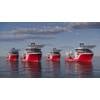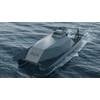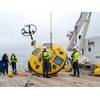China Optimistic of Finding Gas off Vietnam
A Chinese oil rig whose deployment to waters claimed by Vietnam early this month triggered a rupture in ties has a good chance of finding enough gas to put the area into production, Chinese industry experts said.
That would give China its first viable energy field in the disputed South China Sea, as well as make it a source of friction with Hanoi for years to come.
For now, China has said nothing about the potential of the area. The first round of drilling had been completed, the rig operator said on Tuesday, without giving any results from the tapped wells.
The $1 billion deepwater rig owned by state-run China National Offshore Oil Company Group (CNOOC Group), parent of flagship unit CNOOC Ltd, is scheduled to explore until mid-August.
"The place where the rig is drilling at the moment is likely to be a gas field. China conducted three-dimensional geological surveys before moving the rig there," said Wu Shicun, president of the National Institute for South China Sea Studies, a Chinese government think-tank on the southern island of Hainan.
"China is pretty confident ... otherwise they wouldn't start drilling," added Wu, a leading expert on China's ambitions in the South China Sea.
China National Petroleum Corporation (CNPC), the dominant oil and gas producer in China, owns the block being drilled but has given it no name, Chinese officials said. The world's largest energy user imports nearly 60 percent of its oil needs and more than 30 percent of its natural gas.
Exxon Found Oil and Gas Nearby
Deployment of the rig on May 2 set off deadly anti-Chinese riots in Vietnam while scores of Vietnamese and Chinese ships remain squared off around the platform. There have been several collisions.
The rig lies approximately 330 km (205 miles) east of Vietnam and 370 km from the southern coast of Hainan. It is just below the Paracel island chain occupied by China and claimed by Hanoi. Earlier this week the rig was moved after having been some 20 nautical miles closer to central Vietnam's coast.
Hanoi has said the Haiyang Shiyou 981 rig is in its exclusive economic zone. China says its biggest and most advanced mobile energy platform was operating within its waters.
In a 2013 report, the U.S. Energy Information Administration, a government agency, said geological evidence suggested the Paracel islands themselves did not have significant potential in terms of conventional hydrocarbons.
But near the islands the chance of making a major gas discovery was high because there had been several gas finds already in the area, said James Hubbard, head of Asia oil and gas research at investment bank Macquarie in Hong Kong.
"It's not a huge leap of faith to think they might be targeting a gas-prone structure," he said.
Indeed, Vietnam has two fields to the left of the rig, much closer to its coast, where U.S. giant Exxon Mobil Corp discovered oil and gas in 2011 and 2012.
A part of Vietnam's Blocks 118 and 119 fall within China's so-called nine-dash line, a boundary Beijing uses on its official maps to show its claim to 90 percent of the South China Sea. The controversial line extends deep into the heart of maritime Southeast Asia.
Soon after Exxon made its announcement about Block 118 in 2011, China warned foreign energy companies against exploration in disputed areas. It did not name Exxon.
No production had taken place in Blocks 118 and 119, Do Van Khanh, head of state-run PetroVietnam Exploration Production Corporation, told Reuters. He declined to discuss the rig.
In a statement, Exxon said it was in talks with Vietnamese authorities about the feasibility of developing central Vietnam's natural gas resources. It did not respond to questions about the possible impact from China's exploration nearby.
Exxon CEO Rex Tillerson and CNOOC Group Chairman Wang Yilin met in Beijing on May 14, the Chinese company said on its website, adding they discussed "further cooperation" between the two energy giants. It gave no specific details.
A Decade of Surveys
Neither CNOOC Group nor CNPC could be reached for comment on the rig or the field despite repeated attempts. An executive at China Oilfield Services Ltd , the service arm of CNOOC Group and the rig's operator, declined to give details on drilling results so far.
But a Chinese oil industry official with knowledge of the field said a CNPC team which surveyed the block had told him the potential was "pretty good" based on data collected over a 10-year period.
"But of course we won't know the exact amount of reserves until we drill," added the official, who declined to be identified because he was not authorised to discuss the matter with the media.
Experts said if the rig found commercial reserves, China would bring in platforms for production and pipe-laying ships to build the infrastructure to transfer gas to vessels. That process could take several years while production could last decades.
"The tensions between the two sides will absolutely rise to the top if China finds oil in that area," said Duong Danh Dy, a former Vietnamese diplomat.
"There will be more collisions, more conflict. I would not exclude armed conflict."
Discoveries near the coasts of Southeast Asian countries in recent years have been mostly natural gas, reinforcing the belief among geologists and explorers that there is more gas than oil in the South China Sea. Natural gas yields much lower returns than oil because gas is generally cheaper but costs much more to produce, store and transport.
Some energy production is taking place in the South China Sea, but deepwater areas remain untapped, largely because tensions between rival claimants have made oil companies and private oil service companies reluctant to explore contentious acreage well away from sovereign coastlines.
Hanoi, for example, said last week it was considering taking legal action against China following the rig's deployment. The Philippines, another claimant in the South China Sea, challenged China by filing a case with an international arbitration tribunal in late March.
Malaysia, Brunei and Taiwan also claim parts of the South China Sea, whose estimated energy potential varies widely.
Next Stop the Spratlys?
Some Chinese industry experts said they believed the 981 rig - once called "mobile national territory" by CNOOC - would be moved elsewhere in the South China Sea once exploration was completed near the Paracel islands.
They said this would eventually include the Spratlys, an archipelago south of the Paracels where military fortifications belonging to China, Vietnam, Taiwan, the Philippines and Malaysia dot the waterways.
"The rig was designed, meant for oil exploration in the South China Sea," said Lin Boqiang, director of the China Center for Energy Economics Research at Xiamen University and an adviser to China's National Energy Administration, the top regulator of China's energy industry.
"It will move into deep waters in other parts of the South China Sea."
Wu, from the South China Sea Studies institute, said Beijing was sending a clear signal to the international community that it was capable of carrying out deepwater development.
"China should have done this a long time ago but it did not have the tools and technology. It also lacked the capability to safeguard its offshore operations," he said.
(By Charlie Zhu; Additional reporting by Nguyen Phuong Linh in Hanoi, Christine Chan in Singapore and Terry Wade in Houston; Writing by Dean Yates; Editing by Ian Geoghegan)













 August 2025
August 2025



